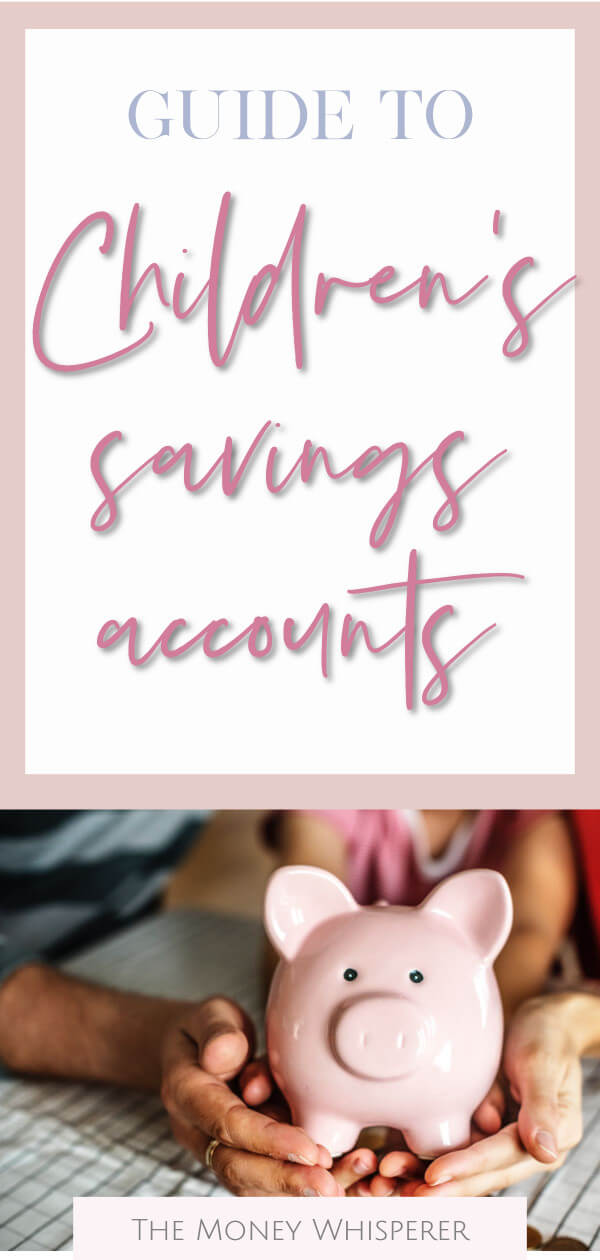This post may contain affiliate links which means that if you click through to a product or service and then buy it, I receive a small commission. There is no additional charge to you.
Guide to Children’s Savings Accounts
When it comes to savings options for children, there are so many it can leave you feeling bewildered and unsure which is best for you and your child. Don’t be paralysed in to inaction; the best time to get saving is always RIGHT NOW so I have some pointers here to help you move forward.
I’ve put together some questions to answer when you are considering how best to save money for children. Your answers to these will frame the best solution for you.
- How much do you have to put save for your children? Is it a lump sum or will you be paying in regularly? Will they be contributing?
- Do you want to lock it away until they are 18? Are you happy for them to access their savings before adulthood?
- Do you want an account with only a set number of withdrawals allowed? Would you prefer that they have easy access to their money whenever they want?
- Do you want to retain some control over the money by keeping it in your name but notionally saving it for your child? Is it important that they understand the money is theirs?
- Are you comfortable with your child having their savings to spend how they want when they are 18?
- Is it important to you to physically visit a bank to show your children about paying money in? Or are you happy with an online account?
- What is your view on risk? Do you want a low risk option? Or would you be happy with higher risk for a potentially higher return on the money you are saving for them?
Remember, the answers to these questions are very unique to each family, and some will be dependent on the age of your children too.
Have a think about your answers and then head over to the RoosterMoney Guide to Children’s Savings Account which provides a really simple and easy to understand overview of the main ways you can save, their features and why each of them may be suitable for you.
The RoosterMoney Guide features the six main ways you can save for children; easy access bank accounts, regular savings accounts, fixed-term bonds, premium bonds, junior Individual Savings Accounts (JISAs) and Child Trust Funds.Click To TweetDo head over to take a detailed look at each of these and consider which would be the best for your family.

What’s right for us…
We have regular saver bank accounts and stocks and shares JISAs for our girls. We also have money in ISAs in our own name for them which we still have control of but which we have said will be for them in the future.
The money held by us can be used for them for things like expensive school trips, driving lessons, buying a car etc, whereas the money in their JISA is locked away until they are 18. At that time, they will be free to spend it how they wish.
We started their JISAs off with a lump sum and now pay regularly in to this as well as their savings accounts.
Any money which they get for birthday or Christmas goes in to my wallet and then the balance gets added to their account on our RoosterMoney app. When they want to spend it, we use the app; I pay and then they have the amount deducted from their balance. It’s great for them while they are still young. Once they are older, we will look at a prepaid children’s card or bank account designed for over 11s.
See my review of the RoosterMoney app here
I think it’s really interesting to hear why people choose different options and have interviewed some fellow parents to see what choices they have made for saving for their own children. Easy access bank accounts were overwhelming popular, for obvious reasons. I couldn’t find anyone who had put money in to fixed-term bonds. Interesting, hey?
Children’s savings account – easy access
Ease of getting to your money and physical bank access is typically the reason why most people opt for easy access accounts. It’s certainly not for the interest as these accounts commonly pay very little interest!
Clare says her two eldest children (9 and 12) have this type of account for ease of accessing their money, although surprisingly they are not actually dipping in to them. Clare was never really taught how to manage money so she is encouraging them to save up for things by paying in any money they’re given for birthdays, Christmas etc. The money is theirs to do whatever they choose with. Her 12 year old has saved up nearly £500 and very rarely dips into it. Her 9 year old daughter always used to just spend as soon as she was given any money, but now she’s trying to catch up to her brother; she has just under £200 now.
I know my nephew’s love to visit their local Metro Bank with their coins to visit the Magic Money Machine. There is definitely something to be said for teaching children about banking by taking them to a branch and showing them how money is paid in and withdrawn. For this reason, in spite of their terrible interest rates, easy access accounts are still popular among parents of children of all ages.
Regular savings accounts
Regular savings account are another account where they do what they say on the tin! You make regular payments in to the account; and often, for this commitment you are rewarded with a higher interest rate than a standard account.
Michelle opened a regular savings account for her son, and pays an amount into it each month. Interestingly, she chose to open it in her name. The monthly amount she pays in is set up to transfer by standing order; she treats it like a bill and doesn’t notice the money going out. When her son gets older, Michelle plans to encourage him to top it up himself as well.
If you could plan to automate your savings for your children, this may afford you a better rate of interest than being sporadic with what you save for them.
Premium bonds
An investment in premium bonds carries the chance of winning from £25 to a £1 million in the monthly prize draw. The money can be accessed fairly quickly if needed and comes with little risk. There is just no guarantee of any upside either as you don’t receive any interest on your money, and you aren’t guaranteed to win in the monthly draw.
When Emma’s children inherited some money last year, she decided to put it in to premium bonds. Her reasoning was that they can withdraw the money easily when they know what they want to spend it on in the future. Whilst the initial investment was a large lump sum, she also encourages them to put in extra at Christmas and birthdays etc. The children like the regular ‘winning’; most months one of them wins £25 so it’s fun for them to see this happen. Emma ensures that they reinvest those winnings in to more premium bonds each month.
Emma likes that premium bonds are zero risk. She doesn’t want any risk associated with their inheritance, which ruled out investing in stocks and shares through a JISA.
Junior Individual Savings Accounts (JISAs)
Junior ISAs are a version of the popular Individual Savings Account, aimed at children. They come in two options: cash or stocks and shares. The key benefit is that any interest, capital gains or dividends earned within the ISA are sheltered from the tax man. Your children’s savings will grow free of any tax in a JISA.
Check out my post on Junior ISAs here
When Nick wanted to invest in the stock market for his 4 month old, he chose a Junior ISA with 3 investments which he contributes to monthly.
We took a similar approach with our girls because of the long time frame until they reach 18 (they were 2 and 4 when we set up their JISAs). Their investments have the potential to grow significantly in that time with the power of compound interest. We are prepared for the ups and downs of the stock market, but believe that by the time they reach 18, the returns will be significantly more than if we had left the money in a bank account.
Child Trust Funds
Child Trust Funds are no longer available (if your child was born between 1 September 2002 and 2 January 2011 you may still have one); they were replaced by Junior ISAs. However, if you still have one, you can continue with it, or move the balance over to a JISA with the guidance of a JISA provider.
CTFs were great because the government set them up for every child during the time they were in operation and funded them with up to £250. Faith’s children were born in 2007 and 2009, when the Government was still handing out free money to encourage parents to start saving for their children. As money in Child Trust Funds can’t be touched until they reach 18, she decided to invest the £100 vouchers in the stock market, hoping for more growth over such a long time than stuck in a savings account. She also started off paying her Child Benefit money into her daughter’s Child Trust Fund, but by the time her son came along, they needed that money to spend! When they reach 18, the money should come in really handy towards education, a first car or a deposit on their first home.
Mix and match
I hope this has given you food for thought when it comes to selecting the right savings vehicle for your child’s savings. Do head over to the RoosterMoney guide to children’s savings accounts for additional guidance. They also have a post specifically dedicated to JISAs too if these are of interest to you.
And remember, review your choices as your small people grow. The answers to those questions I asked you to consider at the beginning will undoubtedly change over their childhood so make sure you re-evaluate your choices at regular points.
If you have short and medium term savings for your children covered and are looking for a long term way to put money away for them, you may want to check out my post on Junior Pensions.
This is a collaborative post.



Thanks for laying this out so simply. Feels like a minefield! x
Great post! I have recently been looking into savings account for my daughter. Now I feel like I can make a more informed decision.
Thanks I do need to think about savings for the kids. At the moment it’s all lumped in with my savings account. I think I should set up their own accounts and will look at the Rooster money guide too.
This is so helpful. It can be so overwhelming when you’re first looking to set up a kids savings account – so many options!
I have got a savings account for my grandson, one that my Mum set up when he was born
We have savings accounts set up for both of my daughter’s. They know money goes in and they can have it when they are 18.
They also receive money each week for doing ‘jobs’ round the house. I want to teach them that they have to earn money and to save up for things they want.
Active funds. I don’t hold that many passive funds (don’t shoot me!) but am starting to drip feed more that way…
I think its best to use an account that can’t be accessed until they are 18 x
Savings accounts that can be added as and when
thank you for all this info im presently looking for a bank account for my son who wants to have a card that he can withdraw money himself when he wants to.
I’ve only ever invested premium bonds for my children but I think it would be good for them to have a bank account of their own. Thanks for the info.
i want an account for my children to use only when they are 18
This is really useful. So much information to help me sort savings for my children
I remember when I was little that there were only really savings accounts for children via the post office. I had a standard savings account with a little blue book and every week when I received my pocket money I would trot to the post office to pay in some savings. I also saved all my coppers and again would take these to the post office every so often to pay them in. I also had premium bonds and I think that’s where my love of the possibility of winning came from.
It all went to pot for me when the post office introduced minimum deposits. I couldn’t afford to pay in £10 or £20 every week so the deposits became less regular.
For my children I’m not worried about them needing the experience of physically going to a bank, building society or post office to make deposits. The future is online so I think it’s important that they can access and view their accounts online.
I think it’s important to set aside some saving for the children. My son’s each have their own savings account and we also have a jar of small change which is divided up every year and put into theirs accounts.
I think it’s important for kids to learn to save mine used to and now my grandchildren do too
Thank you for this really informative post. It is so important to save for a child’s future.
When my children were young (30 years ago) there were no ISAs or investment accounts specifically for children, so we carved out 2 separate investment accounts for them, and paid in a small monthly sum. The kids’ accounts had a different investment profile than ours, and a different asset class allocation. Over the course of 25+ years these grew to hold healthy balances, even though we stopped putting money in when the kids turned 18. Our daughter ended up using hers for the deposit on her first house, and our son used his for equipment to start his own business. It definitely makes sense to start early, as then the compounding effect really has an impact.
So useful, I am looking to set up an account for my daughter to access when she’s 18
This is so helpful. I find it hard to differentiate between the options avaliable. Thanks
Very useful. Thank you.